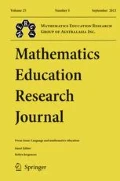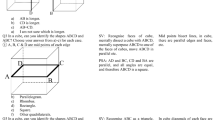Abstract
Measurement concepts such as volume and surface area provide rich contexts for real-world applications of number processes. Despite their importance, many students and prospective teachers show superficial understanding of measurement concepts. A lack of spatial reasoning and integration of geometric knowledge in problem solving situations may be the cause. This study seeks to determine the connection between spatial reasoning and discourse in influencing students’ mathematical reasoning in measurement situations. We analysed 118 year 8 to 10 students’ responses on two scenarios: (1) manipulation of 3D relations in 2D format and (2) explanation of changes in the volume and surface area of a shoe box after enlargement. The results showed that successful reasoners demonstrated a connected, integrated abstraction between numerical and geometric schemes, leading to success in reasoning about volume and surface area situations.











Similar content being viewed by others
References
Arcavi, A. (2003). The role of visual representations in the learning of mathematics. Educational Studies in Mathematics, 52(3), 215–241. https://doi.org/10.1023/A:1024312321077.
Australian Curriculum Assessment and Reporting Authority (ACARA). (n.d.). The Australian Curriculum: Mathematics. Retrieved from http://www.australiancurriculum.edu.au/
Barbin, E., & Rogers, L. (2016). Geometry in the secondary school curriculum and in progression to university. In L. Radford, F. Furinghetti, & T. Hausberger (Eds.), Proceedings of the international study group on the relations between the history and pedagogy of Mathematics satellite meeting (pp. 201–202). Montpellier: IREM de Montepellier.
Barrett, J. E., Clements, D. H., Klanderman, D., Pennisi, S.-J., & Polaki, M. V. (2006). Students’ coordination of geometric reasoning and measuring strategies on a fixed perimeter task: developing mathematical understanding of linear measurement. Journal for Research in Mathematics Education, 37(3), 187–221.
Barrett, J. E., Clements, D. H., & Sarama, J. (2017). Children’s measurement: a longitudinal study of children’s knowledge and learning of length, area, and volume, Journal for Research in Mathematics Education. Monograph Series (Vol.16). Reston: NCTM.
Carroll, J. B. (1993). Human cognitive abilities : a survey of factor-analytic studies. Cambridge, New York: Cambridge University Press.
Casey, B. M., Lombardi, C. M., Pollock, A., Fineman, B., & Pezaris, E. (2017). Girls’ spatial skills and arithmetic strategies in first grade as predictors of fifth-grade analytical math reasoning. Journal of Cognition and Development, 18(5), 530–555. https://doi.org/10.1080/15248372.2017.1363044.
Clements, D. H., Sarama, J., Van Dine, D. W., Barrett, J. E., Cullen, C. J., Hudyma, A., Dolgin, R., Cullen, A. L., & Eames, C. L. (2018). Evaluation of three interventions teaching area measurement as spatial structuring to young children. Journal of Mathematical Behavior, 50, 23–41. https://doi.org/10.1016/j.jmathb.2017.12.004.
Clements, M. (2014). Fifty years of thinking about visualisation and visualising in mathematics education: a historical overview. In M. N. Fried & T. Dreyfus (Eds.), Mathematics and mathematics education: Searching for common ground. Advances in mathematics education (pp. 177–192). Dordrecht: Springer.
Fernández, C., & De Bock, D. (2013). Does the confusion between dimensionality and “directionality” affect students' tendency towards improper linear reasoning? In A. M. Lindmeier & A. Heinze (Eds.), Proceedings of the 37th conference of the International Group for the Psychology of mathematics education (Vol. 2, pp. 297–304). Kiel: PME.
Gagné, R. M., & White, R. T. (1978). Memory structures and learning outcomes. Review of Educational Research, 48(2), 187–222. https://doi.org/10.3102/00346543048002187.
Grabner, R., & Ansari, D. (2010). Promises and potential pitfalls of a ‘cognitive neuroscience of mathematics learning’. The International Journal on Mathematics Education, 42(6), 655–660. https://doi.org/10.1007/s11858-010-0283-4.
Gunderson, E. A., Ramirez, G., Beilock, S. L., & Levine, S. C. (2012). The relation between spatial skill and early number knowledge: The role of the linear number line. Developmental Psychology, 48(5), 1229–1241. https://doi.org/10.1037/a0027433.
Hegarty, M., & Kozhevnikov, M. (1999). Types of visual-spatial representations and mathematical problem solving. Journal of Educational Psychology, 91(4), 684–689. https://doi.org/10.1037/0022-0663.91.4.684.
Huang, H.-M., & Witz, K. G. (2013). Children’s conceptions of area measurement and their strategies for solving area measurement problems. Journal of Curriculum and Teaching, 2(1), 10–26.
Kilpatrick, J., Swafford, J., & Findell, B. (2001). Adding it up: helping children learn mathematics. Washington, DC: National Academy Press.
Knauff, M., Mulack, T., Kassubek, J., Salih, H. R., & Greenlee, M. W. (2002). Spatial imagery in deductive reasoning: a functional MRI study. Cognitive Brain Research, 13(2), 203–212. https://doi.org/10.1016/S0926-6410(01)00116-1.
Kozhevnikov, M., Hegarty, M., & Mayer, R. E. (2002). Revising the visualizer-verbalizer dimension: Evidence for two types of visualizers. Cognition and Instruction, 20(1), 47–77. https://doi.org/10.1207/S1532690XCI2001_3.
Kozhevnikov, M., Kosslyn, S. M., & Shephard, J. (2005). Spatial versus object visualizers: a new characterization of visual cognitive style. Memory & Cognition, 33(4), 710–726. https://doi.org/10.3758/BF03195337.
Lieberman, J. (2009). Using lesson study to develop an appreciation of and competence in task design. In B. Clarke, B. Grevholm, & R. Millman (Eds.), Tasks in primary mathematics teacher education: Purpose, use and exemplars. Mathematics teacher education 4. New York: Springer Science+Business Media, LLC.
Linacre, J. M. (2017). Winsteps Rasch measurement V4.0.0 [computer program]. Chicago: Winsteps.org.
Lord, F. M. (1980). Applications of item response theory to practical testing problems. Mahwah: Lawrence Erlbaum Associates.
Lowrie, T., & Logan, T. (2018). The interation between spatial reasoning constructs and mathematics understandings in elementary classrooms. In K. S. Mix & M. T. Battista (Eds.), Visualizing mathematics: The role of spatial reasoning in mathematical thought (pp. 253–276). Basel: Springer.
Lowrie, T., Logan, T., & Ramful, A. (2017). Visuospatial training improves elementary students’ mathematics performance. British Journal of Educational Psychology, 87(2), 170–186. https://doi.org/10.1111/bjep.12142.
Lowrie, T., Logan, T., & Scriven, B. (2012). Perspectives on geometry and measurement in the Australian curriculum: Mathematics. In B. Atweh, M. Goos, R. Jorgensen, & D. Siemon (Eds.), Engaging the Australian national curriculum: Mathematics - perspectives from the field (pp. 71–88). Online Publication: Mathematics Education Research Group of Australasia.
Masters, G. N. (1982). A Rasch model for partial credit scoring. Psychometrika, 47(2), 149–174. https://doi.org/10.1007/BF02296272.
Mix, K. S. (2019). Why are spatial skill and mathematics related? Child Development Perspectives, 13(2), 121–126. https://doi.org/10.1111/cdep.12323.
Mix, K. S., Levine, S. C., Cheng, Y.-L., Young, C., Hambrick, D. Z., Ping, R., & Konstantopoulos, S. (2016). Separate but correlated: the latent structure of space and mathematics across development. Journal of Experimental Psychology, 145(9), 1206–1227. https://doi.org/10.1037/xge0000182.
Murphy, C. (2012). The role of subject knowledge in primary prospective teachers’ approaches to teaching the topic of area. Journal of Mathematics Teacher Education, 15(3), 187–206. https://doi.org/10.1007/s10857-011-9194-8.
Noss, R., Healy, L., & Hoyles, C. (1997). The construction of mathematical meanings: connecting the visual with the symbolic. Educational Studies in Mathematics, 33(2), 203–233. https://doi.org/10.1023/A:1002943821419.
Outhred, L. N., & Mitchelmore, M. C. (2000). Young children’s intuitive understanding of rectangular area measurement. Journal for Research in Mathematics Education, 31(2), 144–167. https://doi.org/10.1007/978-3-319-02463-9.
Owens, K. (2015). Visuospatial reasoning: an ecocultural perspective for space, geometry and measurement education (2015 ed.). Cham: Springer International Publishing.
Owens, K., & Outhred, L. (2006). The complexity of learning geometry and measurement. In A. Gutiérrez & P. Boero (Eds.), Handbook of research on the psychology of mathematics education. PME (1976–2006). Past, present and future (pp. 83–115). Rotterdam: Sense Publishers.
Pitta-Pantazi, D., & Christou, C. (2010). Spatial versus object visualisation: the case of mathematical understanding in three-dimensional arrays of cubes and nets. International Journal of Educational Research, 49(2–3), 102–114. https://doi.org/10.1016/j.ijer.2010.10.001.
Pólya, G. (1981). Mathematical discovery: on understanding, learning, and teaching problem solving. New York: Wiley.
Presmeg, N. (2006). Research on visualisation in learning and teacing mathematics: emergence from psychology. In A. Gutierrez & P. Boero (Eds.), Handbook of research on the psychology of mathematics education: Past, present and future (pp. 205–235). Rotterdam: Sense Publishers.
Ramful, A., Lowrie, T., & Logan, T. (2016). Measurement of spatial ability: construction and validation of the spatial reasoning instrument for middle school students. Journal of Psychoeducational Assessment, 35(7), 709–727. https://doi.org/10.1177/0734282916659207.
Sáiz, M. (2003). Primary teachers’ conceptions about the concept of volume: the case of volume measureable objects. In N. A. Pateman, B. J. Dougherty, & J. T. Zilliox (Eds.), Proceedings of the 27th Conference of the International Group for the Psychology of Mathematics Education (Vol. 4, pp. 95–102). Honolulu: PME.
Sáiz, M., & Figueras, O. (2009). A research-based workshop design for volume tasks. In B. Clarke, B. Grevholm, & R. Millman (Eds.), Tasks in primary mathematics teacher education: purpose, use and exemplars (pp. 147–160). New York: Springer Science+Business Media, LLC.
Seah, R., & Horne, M. (2018). Middle school students’ reasoning about volume and surface area. In E. Bergqvist, M. Österholm, C. Granberg, & L. Sumpter (Eds.), Proceedings of the 42nd Conference of the International Group for the Psychology of Mathematics Education (Vol. 4, pp. 131–138). Umeå: PME.
Seah, R., & Horne, M. (2019a). A learning progression for geometric reasoning. In D. Siemon, T. Barkatsas, & R. Seah (Eds.), Researching and using progressions (Trajectories) in mathematics education (pp. 157–180). Leiden: Brill Sense Publishers.
Seah, R., & Horne, M. (2019b). The construction and validation of a geometric reasoning test item to support the development of learning progression. Mathematics Education Research Journal. .https://doi.org/10.1007/s13394-019-00273-2.
Sfard, A. (2008). Thinking as communicating: human development, the growth of discourses and mathematizing. Cambridge: Cambridge University Press.
Shield, M., & Dole, S. (2013). Assessing the potential of mathematics textbooks to promote deep learning. Educational Studies in Mathematics, 82(2), 183–199. https://doi.org/10.1007/s10649-012-9415-9.
Shultz, K. S., Whitney, D. J., & Zickar, M. J. (2014). Measurement theory in action: case studies and exercises (2nd ed.). New York: Routledge.
Siemon, D., Tasos, B., & Seah, R. (Eds.). (2019). Researching and using progressions (Trajectories) in mathematics education. Leiden: Brill Sense Publishers
Simon, M. A. (1995). Reconstructing mathematics pedagogy from a constructivist perspective. Journal for Research in Mathematics Education, 26(2), 114–145. https://doi.org/10.2307/749205.
Smith, J. P., Males, L. M., & Gonulates, F. (2016). Conceptual limitations in curricular presentations of area measurement: one nation’s challenges. Mathematical Thinking and Learning, 18(4), 239–270. https://doi.org/10.1080/10986065.2016.1219930.
Tan-Sisman, G., & Aksu, M. (2012). The length measurement in the Turkish mathematics curriculum: Its potential to contribute to students’ learning. International Journal of Science and Mathematics Education, 10(2), 363–385. https://doi.org/10.1007/s10763-011-9304-1.
Tan-Sisman, G., & Aksu, M. (2016). A study on sixth grade students’ misconceptions and errors in spatial measurement: length, area, and volume. International Journal of Science and Mathematics Education, 14(7), 1293–1319. https://doi.org/10.1007/s10763-015-9642-5.
Thomson, S., De Bortoli, L., & Underwood, C. (2016). PISA 2015: a first look at Australia’s results. Melbourne: Australian Council for Educational Research.
Thomson, S., Wernert, N., O'Grady, E., & Rodrigues, S. (2017). TIMSS 2015: reporting Australia’s results. Melbourne: Australian Council for Educational Research.
Vincent, J., & Stacey, K. (2008). Do mathematics textbooks cultivate shallow teaching? Applying the TIMSS video study criteria to Australian eighth-grade mathematics textbooks. Mathematics Education Research Journal, 20(1), 82–107. https://doi.org/10.1007/BF03217470.
Vinner, S. (1991). The role of definitions in the teaching and learning of mathematics. In D. Tall (Ed.), Advanced mathematical thinking (pp. 65–81). Dordrecht: Kluwer Academic Publishers.
Wai, J., Lubinski, D., & Benbow, C. P. (2009). Spatial ability for STEM domains: aligning over 50 years of cumulative psychological knowledge solidifies its importance. Journal of Educational Psychology, 101(4), 817–835. https://doi.org/10.1037/a0016127.
Yilmaz, H. B. (2009). On the development and measurement of spatial ability. International Electronic Journal of Elementary Education, 1(2), 83–96.
Zimmer, H. D., Speiser, H. R., & Seidler, B. (2003). Spatio-temporal working-memory and short-term object-location tasks use different memory mechanisms. Acta Psychologica, 114(1), 41–65. https://doi.org/10.1016/S0001-6918(03)00049-0.
Funding
Commonwealth Government of Australasia (GR-900442445-2014).
Author information
Authors and Affiliations
Corresponding author
Additional information
Publisher’s note
Springer Nature remains neutral with regard to jurisdictional claims in published maps and institutional affiliations.
Rights and permissions
About this article
Cite this article
Seah, R.T.K., Horne, M. The influence of spatial reasoning on analysing about measurement situations. Math Ed Res J 32, 365–386 (2020). https://doi.org/10.1007/s13394-020-00327-w
Received:
Revised:
Accepted:
Published:
Issue Date:
DOI: https://doi.org/10.1007/s13394-020-00327-w




